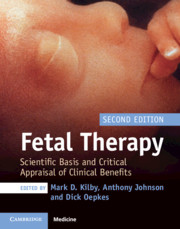Book contents
- Fetal Therapy
- Fetal Therapy
- Copyright page
- Dedication
- Contents
- Contributors
- Foreword
- Section 1: General Principles
- Section 2: Fetal Disease: Pathogenesis and Treatment
- Red Cell Alloimmunization
- Structural Heart Disease in the Fetus
- Fetal Dysrhythmias
- Manipulation of Fetal Amniotic Fluid Volume
- Fetal Infections
- Fetal Growth and Well-being
- Preterm Birth of the Singleton and Multiple Pregnancy
- Complications of Monochorionic Multiple Pregnancy: Twin-to-Twin Transfusion Syndrome
- Complications of Monochorionic Multiple Pregnancy: Fetal Growth Restriction in Monochorionic Twins
- Chapter 36 The Diagnosis and Detection of Fetal Growth Restriction in Monochorionic Twin Pregnancies
- Chapter 37 Clinical Outcome and Management of Selective Fetal Growth Restriction in Monochorionic Twins
- Complications of Monochorionic Multiple Pregnancy: Twin Reversed Arterial Perfusion Sequence
- Complications of Monochorionic Multiple Pregnancy: Multifetal Reduction in Multiple Pregnancy
- Fetal Urinary Tract Obstruction
- Pleural Effusion and Pulmonary Pathology
- Surgical Correction of Neural Tube Anomalies
- Fetal Tumors
- Congenital Diaphragmatic Hernia
- Fetal Stem Cell Transplantation
- Gene Therapy
- Section III: The Future
- Index
- References
Chapter 37 - Clinical Outcome and Management of Selective Fetal Growth Restriction in Monochorionic Twins
from Complications of Monochorionic Multiple Pregnancy: Fetal Growth Restriction in Monochorionic Twins
Published online by Cambridge University Press: 21 October 2019
- Fetal Therapy
- Fetal Therapy
- Copyright page
- Dedication
- Contents
- Contributors
- Foreword
- Section 1: General Principles
- Section 2: Fetal Disease: Pathogenesis and Treatment
- Red Cell Alloimmunization
- Structural Heart Disease in the Fetus
- Fetal Dysrhythmias
- Manipulation of Fetal Amniotic Fluid Volume
- Fetal Infections
- Fetal Growth and Well-being
- Preterm Birth of the Singleton and Multiple Pregnancy
- Complications of Monochorionic Multiple Pregnancy: Twin-to-Twin Transfusion Syndrome
- Complications of Monochorionic Multiple Pregnancy: Fetal Growth Restriction in Monochorionic Twins
- Chapter 36 The Diagnosis and Detection of Fetal Growth Restriction in Monochorionic Twin Pregnancies
- Chapter 37 Clinical Outcome and Management of Selective Fetal Growth Restriction in Monochorionic Twins
- Complications of Monochorionic Multiple Pregnancy: Twin Reversed Arterial Perfusion Sequence
- Complications of Monochorionic Multiple Pregnancy: Multifetal Reduction in Multiple Pregnancy
- Fetal Urinary Tract Obstruction
- Pleural Effusion and Pulmonary Pathology
- Surgical Correction of Neural Tube Anomalies
- Fetal Tumors
- Congenital Diaphragmatic Hernia
- Fetal Stem Cell Transplantation
- Gene Therapy
- Section III: The Future
- Index
- References
Summary
Selective fetal growth restriction (sFGR) affects about 10–15% of monochorionic (MC) twin pregnancies. When presenting during the second trimester, sFGR is a severe complication, with potentially significant risks of intrauterine demise or neurological adverse outcome for both the growth-restricted and the normally grown [1–9] fetuses. Unequal placental sharing (Figure 37.1), often associated with velamentous cord insertion, is the main cause of the development of sFGR in MC twins [10–14]. The natural history of sFGR in MC twins depends both on the discordance in placental territories and on the pattern of placental anastomoses. The blood flow interchange through vascular anastomoses interferes with the natural evolution of placental insufficiency, because the small fetus receives extra oxygen and nutrients from its normally grown co-twin. The pattern of vascular anastomoses, which may differ substantially among MC pregnancies, explains the remarkable differences in clinical course and outcomes that can be observed in pregnancies with similar degrees of fetal weight discordance [1, 12, 15, 16]. Consequently, a large interfetal blood flow interchange will result in a milder clinical course and better outcomes, while placentas with small/few anastomoses and little blood flow interchange will usually be associated with a more severe clinical course. Aside from these, large artery-to-artery (AA) anastomoses connecting the two cords may be present, and also have a strong influence on the clinical evolution.
- Type
- Chapter
- Information
- Fetal TherapyScientific Basis and Critical Appraisal of Clinical Benefits, pp. 392 - 397Publisher: Cambridge University PressPrint publication year: 2020

